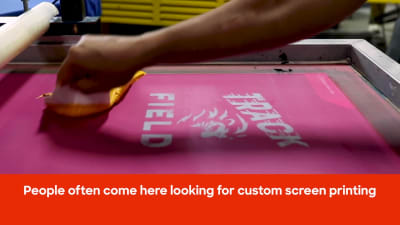Affordable Screen Printing Kit for Home Use
Affordable Screen Printing Kit for Home Use
Blog Article
Screen Printing Uncovered: Whatever You Need to Find Out About Tee Shirt and Garment Printing Strategies
If you've ever before wondered just how those lively styles wind up on your favorite t-shirts, you're in the right location. Display printing is a remarkable approach that incorporates art with technique, supplying limitless opportunities for imagination. Recognizing the principles, from tools to ink selections, can considerably affect your outcomes. All set to discover the essential elements that make screen publishing an art type? Let's reveal the details that can elevate your tasks.
The Essentials of Display Printing: Exactly How It Functions
When you plunge right into display printing, you'll discover it's both an art and a science. At its core, display printing involves creating a pattern, or display, that permits ink to pass via just in particular locations.
Following, you'll blend your inks and prepare your printing surface area. Position the screen over the fabric, after that make use of a squeegee to press ink through the display onto the garment. This procedure requires accuracy, as you desire clear, vibrant prints. After printing, you'll cure the ink with heat, ensuring it abides by the fabric and lasts via cleans. Each action is crucial, and grasping them will elevate your screen printing skills, transforming simple garments right into distinct, meaningful pieces.
Kinds Of Display Printing Strategies
Once you realize the fundamentals of screen printing, it's time to explore the different methods that can elevate your designs. One popular method is typical screen printing, where ink is pressed via a stenciled display. This technique is fantastic for strong, dynamic shades. There's water-based ink printing, which uses a softer feel and is green, yet it requires a different strategy to treating.
If you're intending for fine details, consider discharge printing. This technique removes color from the fabric, leaving a soft, vintage look. Another option is plastisol printing, known for its sturdiness and dazzling colors, making it a preferred for lots of brands. Experiment with halftone printing to produce gradient impacts and detailed styles. Each technique has its unique beauty, so do not be reluctant to attempt them bent on find what matches your design best!
Necessary Tools for Screen Printing
To attain sensational outcomes in display printing, having the appropriate tools is fundamental. Initially, you'll need a durable display printing frame, which holds the mesh that moves your design onto the garment. Next, invest in high-grade squeegees; these are important for using ink uniformly across the display. You'll additionally need a great exposure device to produce your displays, as well as a washout cubicle for cleaning them after use. A reliable warm resource, like a conveyor clothes dryer or heat press, is critical for curing your prints to guarantee long life. Do not forget a correct work space, geared up with tables and storage space for your materials. Safety gear, such as handwear covers and masks, will certainly keep you safe from chemicals and inks. With the right tools, you'll be well on your way to producing professional-quality prints.
Picking the Right Inks and Products
When picking inks and products for display printing, you need to take right into account the kind of ink that functions finest for your job. Think of fabric compatibility to guarantee your styles look great and last long. Check out environmentally friendly ink choices to make your printing procedure extra sustainable.
Sorts Of Screen Inks
Selecting the right display ink is essential for attaining dynamic, sturdy prints that meet your task's requirements. There are several types of screen inks to check out. Plastisol ink is prominent for its adaptability and ease of usage, offering exceptional color opacity on dark fabrics. Water-based ink, on the various other hand, offers a softer feeling and is environmentally friendly, making it ideal for those seeking to decrease their ecological influence. Discharge inks eliminate dye from the fabric, leading to a soft, classic look yet call for particular handling. Lastly, specialized inks, such as glow-in-the-dark or metal, can add distinct impacts to your styles. Review your job needs and pick the ink that aligns best with your wanted outcome.

Fabric Compatibility Factors To Consider
Comprehending textile compatibility is essential for achieving high-quality display prints, especially since different materials react distinctively to numerous inks. When selecting inks, take into consideration the textile type-- cotton, polyester, or blends. For cotton, water-based inks function well, providing softness and breathability. Polyester, on the various other hand, commonly calls for plastisol inks for far better adhesion and vivid shades. You could require to use a mix of both types if you're printing on blends. Constantly test your inks on example fabric to guarantee they stick properly and keep shade integrity. In addition, bear in mind that material weight and appearance can affect the last outcome, so selecting the ideal ink and material combo is essential for your task's success.
Eco-Friendly Ink Options
Green inks are ending up being a popular option for screen printers who want to reduce their environmental effect while preserving high quality. When selecting inks, take into consideration water-based inks, which are much less hazardous and simpler to clean up compared to typical solvents.
In addition, seek inks made from renewable energies, such as soy or vegetable-based choices. By choosing the best inks and materials, you'll not just create stunning styles yet additionally add to a much more sustainable printing procedure. Make the switch, and your prints will show your dedication to the environment!
Preparing Your Design for Screen Printing

Submit Style Requirements
To ensure your design looks sharp and vibrant on fabric, you'll need to pay close focus to submit layout needs for display printing. Make sure your style has a transparent history to stop unwanted white edges on your prints. Maintain color modes in mind; CMYK is basic for display printing, so convert your RGB creates as necessary.
Shade Splitting Up Techniques
Color separation is a necessary step in preparing your layout for screen printing, and understanding it can greatly enhance your print high quality. You'll need to break your style into private shades, as each color needs a separate display throughout printing. This accuracy not only guarantees accurate color depiction however also simplifies the printing process.
Resolution and Size
Accomplishing the very best results in display printing starts with ensuring your design has the ideal resolution and dimension. Ideally, your artwork needs to go to least 300 DPI (dots per inch) for sharp, clear prints. Your last item might look less than professional and pixelated. if you make use of lower resolution.
When it involves size, take into consideration the measurements of your print area. Layout your artwork to match the final print dimension, preferably producing it in the actual measurements you'll be printing. This method, you'll stay clear of any type of unexpected scaling problems.
Always check your design in both vector and raster formats. Vector graphics can be scaled without shedding quality, making them perfect for display printing. Preparing properly will guarantee your design looks amazing on every garment!
Step-by-Step Screen Printing Refine
Display printing is a dynamic process that permits you to produce vibrant designs on numerous surfaces. To start, you'll need a screen, solution, and your picked ink. First, prepare your display by cleaning it completely. Next off, apply the solution uniformly and let it dry in a dark area. Once dry, subject your screen to light with your style positioned useful content on it, which will set the solution where the light hits, producing a pattern - screen printing kit.
Pour ink onto the screen and make use of a squeegee to push the ink with the stencil onto the textile. Lift the display carefully and let the print dry. You have actually efficiently display printed your design.
Tips for Successful Screen Printing Projects
While you're diving right into your display printing tasks, keep in mind that prep work is essential to success. Start by gathering all your products-- inks, screens, garments, and squeegees. A clean workspace helps stop undesirable errors, so clean before you begin.
Next, validate your artwork is high-resolution and properly sized for your garment. Test your screen for appropriate exposure and clean it thoroughly to avoid spots. When mixing your inks, comply with the supplier's guidelines to attain the right uniformity.
Throughout printing, use even stress with your squeegee for regular results. Don't rush; take your time to confirm each print meets your requirements. After printing, allow your garments dry completely before taking care of or packaging them.
Lastly, constantly maintain a sample of your job Homepage for future reference. By doing this, you can examine your development and improve your methods in time. Satisfied printing!

Frequently Asked Questions
For how long Does It Require To Establish a Display Printing Work?
Establishing a screen printing task typically takes about half an hour to an hour. You'll prepare the displays, mix inks, and readjust journalism. The moment varies based upon intricacy and experience, so remain organized!
Can I Print on Various Material Types Utilizing the Exact Same Method?
Yes, you can print on various fabric types using the very same technique, however you'll need to adjust your inks and settings. Some fabrics take in ink differently, so experimenting assurances the very best results for each material.
What Prevail Errors to Stay Clear Of in Screen Printing?
When screen printing, avoid typical errors like using the wrong ink, ignoring proper exposure times, or missing pre-press checks. Constantly evaluate your configuration and preserve tidy screens to assure top quality outcomes each time.
Just How Can I Properly Tidy and Keep My Display Printing Tools?
To effectively tidy and maintain your screen printing tools, you should consistently clean displays with ideal solvents, inspect mops for wear, and ensure all devices are stored dust-free and completely dry. Consistency stops expensive repairs and boosts performance.
Is Display Printing Eco-friendly Contrasted to Various Other Techniques?
Screen printing can be more eco friendly than various other approaches, specifically if you utilize eco-conscious materials and water-based inks. By choosing lasting supplies and techniques, you minimize waste and lessen your influence on the planet.
Screen Printing Uncovered: Everything You Required to Know Concerning T-Shirt and Garment Printing Strategies
At its core, screen printing includes developing a stencil, or display, that allows ink to pass via just in particular areas. Placement the display over the fabric, after that make use of a squeegee to press ink through the screen onto the garment. One popular technique is traditional display printing, where ink is pressed through a stenciled display.When choosing inks and materials for display printing, you need to take into account the type of ink that functions ideal for your project.
Report this page